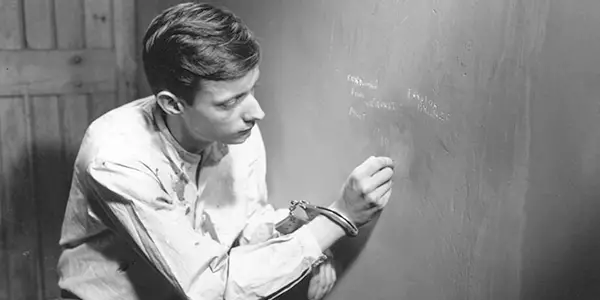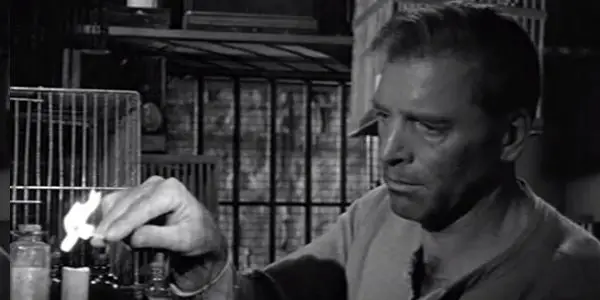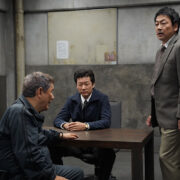Film Inquiry Recommends: Prison Films

Alex is a 28 year-old West Australian who has a…
Over at our official Facebook page, we are currently posting daily film recommendations, with each week being a different theme. This is a collection of those recommendations! This week’s theme is prison films.
Prisons provide an interesting settings for films for a variety of reasons, as the claustrophobic and closed-in settings cause tight restrictions in terms of characters and storytelling. Prisoners are always restricted in their actions and are usually criminals, a type of character that is hard to make sympathetic and likeable to a mainstream audience.
This leads to a common trope in prison films of the main character being an innocent man who is falsely imprisoned, or a charismatic rebel, which can be seen in some of the best known prison films such as The Shawshank Redemption, Cool Hand Luke and Bronson. Here is just a selection of some of the more underrated prison films that are worth watching.
1. A Man Escaped (1956, Robert Bresson)

Robert Bresson was one of the major figures in the French New Wave cinematic movement, a minimalist filmmaker who used non-actors, minimal use of soundtrack and a progressive editing in creating his classic films. Fellow French New Wave director Jean-Luc Goddard stated “Robert Bresson is [to] French cinema, as Dostoevsky is the Russian novel and Mozart is German music.” Even when dealing with genre pictures, Bresson managed to develop them into his own distinctive style. A Man Escaped is a prison film which focuses on the mentality of the protagonist rather than the typical action film tropes associated with many other prison movies. Other genre pictures that Bresson shifted expectations with include the crime picture Pickpocket and the coming of age story in Mouchette.
Set during World War 2, French Resistance fighter Fontaine (François Leterrier) is captured and sent to a stark Nazi prison where he awaits a death sentence. He’s left to starve and mostly ignored by the Nazi guards, as he slowly wastes away. He decides to devise a plan to escape, which involves a late night escape attempt using handmade rope and materials taken from various Nazi guards. Fontaine’s plan is on track until a mysterious prisoner is forced to live in the same cell as him.
Whilst the prisoner states he is another resistance fighter who was captured, Fontaine’s growing fear of being captured and heightened paranoia has him thinking the prisoner could possibly be an undercover agent planted by the German guards planted to thwart his escape plan. This leaves Fontaine with a dilemma: trust the prisoner and have him escape with him, or kill the prisoner and go alone.
A Man Escaped demonstrates Bresson’s understated ability to build suspense without the use of manipulative music or contrived screenwriting. Bresson’s command of cinematic language is frequently present throughout A Man Escaped, such as the claustrophobic cinematography, François Leterrier’s dread-filled central performance and the sporadic use of score in key moments, this film is an essential arthouse title for any students of film and one of the best in Bresson’s filmography.
2. Cell 211 (2009, Daniel Monzón)

Rookie Prison guard Juan Oliver (Alberto Ammann) is accidentally left inside a prison cell when a full scale riot goes down. In order to stay alive, he poses as a prisoner and slowly starts to become friendly with the head of the riot, Malamadre (Luis Tosar), whilst some of the other prisoners start to suspect something is off with this new prisoner. With Juan’s pregnant wife waiting for him on the outside, the media circling around the riot and Malamadre having to constantly assert power, Juan must fight to stay alive.
It’s a great premise and Monzón directs it really well, slowly tightening the tension and building the suspense as Juan has to keep covering his tracks and keeping us his prisoner façade in order to stay alive. Some of the action scenes within the prison are quite brutal and the film heightens the realistic aspects of the film, without revelling in the brutality or gore of the scenes. The film is quite a bleak adventure, which avoids the tropes of usual Hollywood films. Overall, the film is quite solid, from the acting, cinematography and ability to keep the audience engaged throughout.
3. Brute Force (1947, Jules Dassin)

Those who recently watched the Oscar nominated Trumbo were reminded of just how terrible the Hollywood blacklist era was, and how harmful it was to the careers of hundreds of people within the Hollywood bubble and beyond. Jules Dassin was an American genre director who was unfairly targeted by the blacklisting witch-hunt, which forced him to move to France, a move which inadvertently flourished his career and made him the classic arthouse director he is remembered as today. His most famous films include the hugely influential bank heist film Rififi, realistic police drama The Naked City and the bleak crime film Night and the City, which was later remade in the 90’s with Robert DeNiro.
After being released from solitary confinement, Joe Collins (Burt Lancaster) finds out that his wife has turned down surgery for her deadly cancer, only choosing to go through with it if Joe can be by her side. This triggers Joe to desperately trying to get out of jail, where he plans a violent plan with fellow prisoner Gallagher (Charles Bickford). By chance, other prisoners start a violent out-of-control riot that takes over the entire prison, which gives Joe his chance to try and finally escape the joint.
In a time when prison films were churned out, which were usually underdog stories where good-hearted prisoners were put in awful scenarios and succeeded, Brute Force flipped this on its head with its bleak tale of oppression and addressing the role of violence in society. Whilst the film is anchored by Burt Lancaster, one of the big roles which launched him into mainstream fame, the film features an impressive cast of characters who are given their own personalities and histories – Dassin’s attempt to humanise these prisoners. The film’s stark black and white imagery, intelligent screenplay and surprising use of violence makes Brute Force one of the defining prison films, one which would go onto become majorly influential to the prison film genre.
4. Birdman of Alcatraz (1962, John Frankenheimer)

Another prison film starring Burt Lancaster, who plays an entirely different role than his violent rebel in Brute Force. Birdman of Alcatraz was one of the many collaborations between John Frankenheimer and Burt Lancaster, an electric duo whose collaborations rival the famous director/actor duos such as Scorsese/DeNiro and Kurosawa/Toshiro Mifune. Birdman of Alcatraz is a largely fictionalised take on the true tale of Robert Stroud, a peaceful inmate who cared for a variety of birds within his cell in Leavenworth Prison, but when moved to Alcatraz, was forced to get rid of them.
Robert Stroud (Lancaster) is a young man who is imprisoned for murder, where he his youthful energy makes him a rebellious instrument within the prison, which constantly aggravates all the prison guards. When he finds out that his mother has been rejected a visit, Stroud flips out and accidentally kills a guard, which garners him a death sentence. After his mother successfully calls for a life in prison sentence instead, Stroud is forced into solitary confinement for the rest of his life. Growing increasingly isolated, he decides to help raise a young sparrow, which sparks a passion for birds, as his collection of birds slowly increases. This passion starts to sooth the ageing Stroud, highlighting his understated intelligent side and turns him into a model prisoner.
The film was highly criticised due to its sympathetic portrayal of Robert Stroud, which clashed with many people’s personal reports who identified him as a violent psychopath, with some critics stating that Birdman of Alcatraz was a comedy rather than a drama due to how inaccurate it was. Removing truthful backbone of the story, as its own fictional story, the film is quite good. This was made when Frankenheimer was in his prime, one man who knew how to use black-and-white photography to full effect. The unusual subject matter is treated in an interesting manner, turning this true story into quite a unique prison film, one of the more eclectic ones on this list.
5. The Hill (1965, Sidney Lumet)

A prison film of a different nature, The Hill is one of Sidney Lumet’s more underrated efforts, a film which gave Sean Connery a platform for one of his best acting performances. This prisoner camp/World War 2 movie is an intelligent study into justice and the limits of human spirit, photographed in a terrific black and white cinematography which really highlights the tremendous heat conditions that the prisoners were forced to work under.
In a North African military prison during World War 2, five new detainees enter the prison, including mysterious british soldier Joe Roberts (Sean Connery). The disciplinary camp is run by the compassionate R.S.M. Andrews (Harry Andrews), whose brutal subordinate, Staff Sergeant Williams (Ian Hendry) runs the camp in a sadistic, overbearing fashion. His main method of torturing the prisoners is to make them climb “The Hill” a man-made pyramid, which combined with the steep and rugged surface, forced to wear weights and the hot Egyptian sun, slowly mentally and physically breaks the men until they die or become model prisoners. The new set of detainees are subject to these torturous methods, who each have their own way of dealing with pain, including rebellion and falling into the system.
Between this and the underrated cop drama The Offence, Lumet really knew how to pull a humanising and genuine performance out of Sean Connery, an iconic actor who is usually criticised for his gruff, low-key performances that depended on his unique accent and looks rather than great acting chops. Whilst we’re highlighting Connery, we should also praise the rest of the cast, who all do great jobs respectively, which shows the talents of Lumet as a talented actor-director and the solid cast he assembled for the film. Between the realistic tone, tight editing, crisp monochrome cinematography and great acting, The Hill is definitely a unique prison film to check out.
6. Ghosts… of the Civil Dead (1988, John Hillcoat)

The debut feature of Australian director John Hillcoat, whose new film Triple 9 has just come out in cinemas, is a mainstream cop procedural which is a large departure from his work here. Based on Jack Henry Abbott’s 1981 prison memoir, “In the Belly of the Beast”, Hillcoat, along with his fellow co-writers Evan English, Gene Conkie, Nick Cave and Hugo Race wrote an authentic, episodic but often brutal jail film.
This film is one of Hillcoat’s many collaborations with musician Nick Cave, who worked on the script, did the score and acts in the film. Alongside Cave, the film casts ex-prisoners in some of the roles, who were consulted by former prison guards, which adds a realistic feel to the picture. Due to the nature of the novel the film is based off, the film has an eclectic, vignette style, which threads multiple narrative threads towards a slowly erupting prison riot in the fictional Central Industrial Prison. Hillcoat uses a variety of different cinematic techniques, developed by his years making music videos, which include multiple voice-overs, montages and frequent colour palette changes.
The film takes place within Central Industrial Prison, a facility built to imprison the most violent and chaotic criminals. In the past 37 months the prison has existed in a state of permanent lockdown due to the uncontrollable inmates, which include the likes of Wenzil (David Field), the closest to a central character in the film, the violent Maynard (Nick Cave) and more, whose separate states of isolation and rage are quietly fuelling a toxic atmosphere, which is on the verge of a meltdown.
The film explores the themes of dehumanisation and the effects that the prison system has on those involved, including the prisoners and the guards that watch over them. Whilst not for the faint-hearted due to the film’s often violent imagery, it is an impressive debut which lead to a string of original genre pictures by Hillcoat, which include 2005’s The Proposition, 2009’s The Road and 2012’s Lawless. Sadly the film is quite hard to get a hold of, even with the film’s cult status due to Nick Cave’s involvement and the film’s subversive nature, one which deserves a high-def revival, especially with Hillcoat’s name being put into the mainstream knowledge as of late.
7. Riot in Cell Block 11 (1954, Don Siegel)

Riot in Cell Block 11 is a bleak prison drama from Don Siegel, the great action director behind genre classics such as Dirty Harry, Charley Varrick and Escape From Alcatraz, another awesome prison film which missed out on a placement on this list. Riot in Cell Block 11 is one film where the behind the scenes drama trumps the film’s actual content, due to amount of problems that arose and the various famous people who got involved.
The biggest behind-the-scenes fact about the film is that it provided the first feature film credit for legendary director Sam Peckinpah, who worked on the role as third assistant casting director. This came in handy as his family’s history as court judges was well-known to the warden of the jail where Siegel wanted to shoot, thus he allowed the crew to film within his jail due to Peckinpah’s connection. Impressed by Siegel’s directing choices, Peckinpah worked on four more of Siegel’s films. Due to shooting in a real prison, the set is filled with real prisoners and guards, whilst it adds an authentic edge to the visuals, it caused a lot of problems for the crew who were trying to make the movie.
Film producer Walter Wagner decided to make the film after being released from a short prison sentence, where he was incarcerated for shooting a man that he believed was having an affair with his wife. He teamed up with Siegel in an attempt to make a semi-realistic prison film based on the experiences that he went through when locked up. Riot in Cell Block 11 is about James V Dunn (Neville Brand), a man with a life sentence in jail, who leads his fellow prisoners in igniting a riot in order to attempt to get better living conditions. As the riot starts to get expanded media attention, Dunn starts to manipulate it in his fashion.
Whilst the film avoids any real brutality, painting prison life in a much more positive fashion than any one of the other films in this list, Riot in Cell Block 11 is still an effective drama, which does a great job of highlighting the role that the media plays in any conflict that happens around the world. The film’s satirical tone against media manipulation and the control that journalism has on our perception of society is achieved successfully, with a very similar feeling to Billy Wilder’s underrated Ace in the Hole.
What are some other prison films that you can recommend?
Does content like this matter to you?
Become a Member and support film journalism. Unlock access to all of Film Inquiry`s great articles. Join a community of like-minded readers who are passionate about cinema - get access to our private members Network, give back to independent filmmakers, and more.













